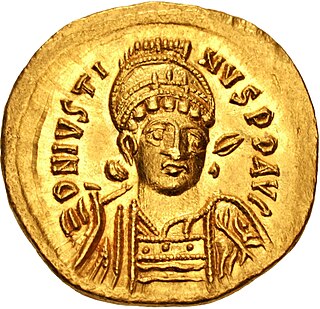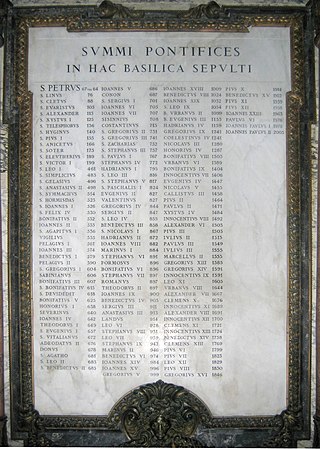Life
Early life and election as bishop
Of Germanus's life before he was bishop nothing is known with certainty. The only source to provide information about this period is a hagiography penned in the ninth century. It records his father's name as Amantius and his mother's as Juliana. He was born in Capua in the 470s. After his father's death, he sold his inheritance with his mother's blessing in order to devote himself to the ascetic life. When on the death of Bishop Alexander the Capuans elected him their bishop, Germanus at first refused the honour before being persuaded to accept. This account of his early life cannot be substantiated in other sources.
Mission to the East in 519–520
At the time of his election, Capua lay within the Ostrogothic Kingdom. Shortly after his election, he was made a member of the legation sent by Pope Hormisdas to the court of the Emperor Justin I in Constantinople, the purpose of which was to negotiate an end to the Acacian schism between the western and eastern churches. The contemporary Liber pontificalis refers to him as "Capuan bishop" (Capuanus episcopus) in connection with this legation and provides a terminus ante quem for his assumption of episcopal office. The legation consisted of Germanus, the Alexandrian deacon Dioscorus, a bishop named John, a Roman deacon named Felix, a Roman priest named Blandus and a notary named Peter. They gathered in Rome between January and March 519. In both the Liber pontificalis and the letters of Pope Hormisdas, Germanus is always named first, indicating that he was the leader of the group.
The mission of 519 was the third such papal initiative since the schism began in 482. That of 496–497 also involved a bishop named Germanus, who in early scholarship was often identified with the Germanus of 519. It has been shown, however, that these were different people. The legate of 496 was Germanus of Pesaro. Although the two previous missions had yielded no results, that of 519 took place in propitious circumstances. It had the support of the Ostrogothic king Theoderic and of the new emperor and patriarch in Constantinople, Justin I and John of Cappadocia. In a letter to Justin's nephew, Count Justinian, Pope Hormisdas specifies that the members of his legation were selected for their "quality".
Germanus's itinerary on his legation is known primarily from various letters. They crossed the Adriatic to Aulon, then passed through Lychnidus on their way to Thessalonica, where Germanus celebrated mass. They were met by Justinian ten miles outside of Constantinople. According to a letter from Germanus to Hormisdas dated 22 April 519, the population of the city received them with cheering. They met the emperor and separately the Senate on the Monday of Holy Week (24–31 March). On Thursday, they met with the emperor, Senate and patriarch all at once in the Palace to present the libellus Hormisdae , the document entrusted to them by the pope outlining his conditions for the healing of the schism. The conditions were accepted. Germanus and his colleagues remained in the east for another year securing the acceptance of the libellus outside of Constantinople. On 9 July 520, the emperor wrote to Pope Hormisdas to commend his legates. The Liber pontificalis credits Germanus with deftly handling the Theopaschite controversy, the calculation of the date of Easter and the reintegration of bishops deposed by the Emperor Anastasius I.
Later career, death and veneration
Little is known of Germanus's pontificate after the end of his successful mission to the east. According to the tenth-century Chronicon Salernitanum , Germanus changed the dedication of the Constantinian basilica of Capua from the Apostles to Saints Stephen and Agatha after depositing there some of their relics that he had obtained as a reward from the emperor himself. According to his eighth- or ninth-century biography, Bishop Sabinus of Canosa was an acquaintance of Germanus. Both went on papal missions to fight monophysitism in the eastern churches, Sabinus in 536. Sabinus was also close to Benedict of Nursia. Pope Gregory the Great in his Dialogues mentions how Benedict, praying atop Monte Cassino, had a vision of the soul of Germanus in the form of a ball of fire being carried to heaven by angels. He later learned that this vision coincided with Germanus's death.
The death of Germanus can be placed in early 541 because of an inscription which gives the start of his successor Victor's pontificate in that year. After his death, Germanus was venerated as a saint in southern Italy throughout the early Middle Ages. In his Dialogues, Gregory the Great prays to Germanus to intercede on behalf of the soul of a deacon named Paschasius in Purgatory. When Count Lando I of Capua relocated the city of Capua in 849, Germanus's body was moved with it. In late 873, following a campaign against the Arabs harassing Capua, the Emperor Louis II of Italy took some of Germanus's relics to Monte Cassino, according to the Chronica monasterii Casinensis . The village at the foot of the hill, ancient Casinum, became known as San Germano. The Empress Engelberga took another part of his relics to endow the monastery of San Sisto that she founded in Piacenza in 874. Since the Vita sancti Germani episcopi Capuani (Life of Saint Germanus) mentions neither of these transfers, it was probably finished before 873.
Pope Anastasius II was the bishop of Rome from 24 November 496 to his death. He was an important figure in trying to end the Acacian schism, but his efforts resulted in the Laurentian schism, which followed his death. Anastasius was born in Rome, the son of a priest, and is buried in St. Peter's Basilica.
The 480s decade ran from January 1, 480, to December 31, 489.

Justin I, also called Justin the Thracian, was Eastern Roman emperor from 518 to 527. Born to a peasant family, he rose through the ranks of the army to become commander of the imperial guard and when Emperor Anastasius died, he out-maneouvered his rivals and was elected as his successor, in spite of being around 68 years old. His reign is significant for the founding of the Justinian dynasty that included his eminent nephew, Justinian I, and three succeeding emperors. His consort was Empress Euphemia.
Pope Gelasius I was the bishop of Rome from 1 March 492 to his death on 19 November 496. Gelasius was a prolific author whose style placed him on the cusp between Late Antiquity and the Early Middle Ages. Some scholars have argued that his predecessor Felix III may have employed him to draft papal documents, although this is not certain.
Pope Felix III was the bishop of Rome from 13 March 483 to his death. His repudiation of the Henotikon is considered the beginning of the Acacian schism. He is commemorated on March 1.

Pope Hormisdas was the bishop of Rome from 20 July 514 to his death. His papacy was dominated by the Acacian schism, started in 484 by Acacius of Constantinople's efforts to placate the Monophysites. His efforts to resolve this schism were successful, and on 28 March 519, the reunion between Constantinople and Rome was ratified in the cathedral of Constantinople before a large crowd.
Pope John I was the bishop of Rome from 13 August 523 to his death. He was a native of Siena, in Italy. He was sent on a diplomatic mission to Constantinople by the Ostrogoth King Theoderic to negotiate better treatment for Arians. Although John was relatively successful, upon his return to Ravenna, Theoderic had him imprisoned for allegedly conspiring with Constantinople. The frail pope died of neglect and ill-treatment.

Germanus I was an ethnic Latin who was the Patriarch of Constantinople from 715 to 730. He is regarded as a saint by both the Orthodox and Roman Catholic Churches, with a feast day of 12 May. He had been ecumenically preceded by Patriarch John VI of Constantinople, and was succeeded in Orthodox Rite by Patriarch Constantine II of Constantinople.
Acacius served as the Ecumenical Patriarch of Constantinople from 472 to 489. He was practically the first prelate in all of Eastern Orthodoxy and was renowned for his ambitious participation in the Chalcedonian controversy. His controversial attempts at healing the theological divisions led to the Acacian schism and his being condemned by the Chalcedonian churches. He is revered as a saint in Oriental Orthodoxy.
John II, surnamed Cappadox or the Cappadocian, was Patriarch of Constantinople in 518–520, during the reign of Byzantine emperor Anastasius I after an enforced condemnation of the Council of Chalcedon. His short patriarchate is memorable for the celebrated Acclamations of Constantinople, and the reunion of East and West after a schism of 34 years. At the death of Timothy I, John of Cappadocia, whom he had designated his successor, was presbyter and chancellor of the Church of Constantinople.
The Henotikon was a christological document issued by Byzantine emperor Zeno in 482, in an unsuccessful attempt to reconcile the differences between the supporters of the Council of Chalcedon and the council's opponents. It was followed by the Acacian schism.
Dioscorus was a deacon of the Alexandrian and the Roman church from 506. In a disputed election following the death of Pope Felix IV, the majority of electors picked him to be pope, in spite of Pope Felix's wishes that Boniface II should succeed him. However, Dioscorus died less than a month after the election, allowing Boniface to be consecrated pope and Dioscorus to be branded an antipope.
John Talaia was patriarch of Alexandria from 481 until 482. He was consecrated in 481, succeeding Timothy III Salophakiolos.
Germanus or Germanos (Greek) may refer to:

The Archdiocese of Capua is a Latin diocese of the Catholic Church in Capua, in Campania, Italy, but its archbishop no longer holds metropolitan rank and has no ecclesiastical province. Since 1979, it is a suffragan of the Archdiocese of Napoli, i.e. no longer has its own ecclesiastical province nor metropolitan status.
The Scythian monks were a community of monks from the region around the mouths of the Danube, who played an influential role in Christian theological disputes between the 4th and 6th centuries. The name Scythian comes from Scythia Minor, the classical name of the modern Dobruja region in Romania and Bulgaria, at the time a Roman province. The monks were raised not only from local Christian elements, but also from immigrant Christians who came to live ascetic lives.

The Acacian schism, between the Eastern and Western Christian Churches, lasted 35 years, from 484 to 519. It resulted from a drift in the leaders of Eastern Christianity toward Miaphysitism and Emperor Zeno's unsuccessful attempt to reconcile the parties with the Henotikon. The events are described in letters in the Collectio Avellana.

Saint Sabinus of Canosa, venerated as a saint in the Roman Catholic church, was bishop of Canosa di Puglia from 514.

The Placidia Palace was the official residence of the papal apocrisiarius, the ambassador from the pope to the patriarch of Constantinople, and the intermittent home of the pope himself when in residence at Constantinople. The apocrisiarius held "considerable influence as a conduit for both public and covert communications" between pope and Byzantine emperor.
The apocrisiarius or apocrisiary was the legate from the pope to the patriarch of Constantinople, circa 452–743, equivalent to the modern nunciature.







